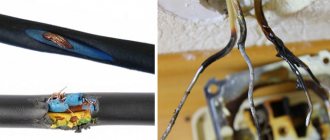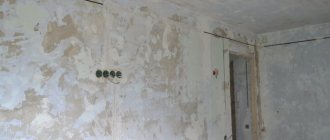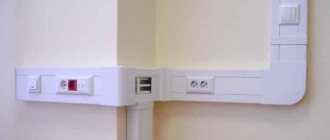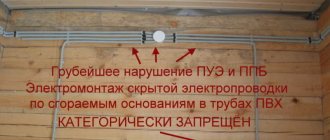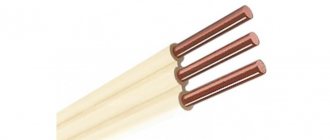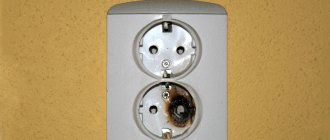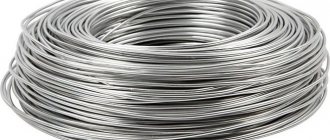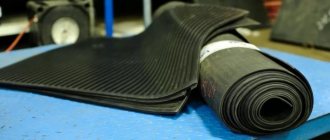Disadvantages of electrical wiring
The technical requirements of the present time and various regulatory reference books indicate installation only from copper wires due to the increased loads on the electrical network, which aluminum can no longer withstand.
In addition, the insulation ages quickly, since conductors made of such material often heat up, exceeding the norm. Wires tend to oxidize quickly and are not as flexible as copper alloy. This is noticeable in the connections and bends of the wire, which has been repaired more than once. Humidity and poor contacts pose a risk of overheating and fire.
Aluminum wiring was originally designed for 25 years of operation, and in many places this period has long expired and requires urgent replacement. The reasons are:
- Planned electrical installation work regardless of the state of the electrical networks.
- Broken insulation - these places will heat up and the metal will melt.
- Broken conductors - current leaks through the damaged areas.
- Risk of short circuits due to various obvious and hidden disturbances in the electrical network.
- The appearance of burning odors, sparks at points of unreliable connection, at break points, which will lead to a fire.
- Frequent automatic shutdown of protective devices.
- Periodic disconnection of power supplies.
- Installation of powerful household appliances, the operation of which cannot be ensured by old wires.
It is imperative to change the network if a danger arises:
- Fires.
- Life and health of inhabitants.
The technical characteristics of aluminum as a conductor are mainly negative; they exceed all its positive properties:
- Low electrical conductivity.
- High level of oxidation in reaction with air.
- Average service life, after which a fire may occur due to a short circuit in the conductor.
- Weak mechanical strength.
- Due to the fluidity of the metal, when aluminum is stretched, the connections weaken, so they heat up and oxidize.
- Fragility of wires due to long service life, stress and overheating.
The copper conductor left all the negative properties of the aluminum conductor, but took away only one minus - the high cost of the material.
Advantages of aluminum wiring
Aluminum wiring is lightweight and corrosion resistant.
The material is lightweight. This fact makes it possible to lay wiring in large buildings without significant load on the foundation. For the same reason, aluminum cable is considered a priority for laying power lines. During Soviet times, almost all buildings were powered with this material.
The metal is resistant to corrosion. When open, aluminum immediately enters into a chemical reaction with oxygen. As a result, a film is formed, which in turn protects the wire from further oxidation.
Another advantage is the low price. When comparing wiring to a similar copper product, the former costs less.
Is it worth replacing old aluminum wiring?
This question can be answered with confidence and unequivocally: yes, it’s definitely worth it! The use of old aluminum wiring with the current modern loads on the electrical network is not only ineffective, but also not safe. Moreover, according to the PUE, aluminum wires cannot be used when installing wiring in a house. Therefore, if it is possible to change the electrical wiring, then you should definitely change it to copper with the correct calculation, selection of the cross-section and number of electrical lines.
Electrical installation work is a case where you cannot skimp on the quality of materials. The safety of people and the proper operation of electrical appliances in the house depend on the correct selection and calculation of materials.
If you still decide to keep the old electrical wiring, then you should redo the panel, limit the power and protect each line from exceeding the load above 16 A (this will allow you not to worry that at some point the wiring will overheat and catch fire).
Although copper wiring is much more expensive than aluminum, it pays off in the long run and does not cause problems for the user.
Is it worth changing the old wiring?
The answer to this question is unequivocal – Yes! One of the nuances that speak in favor of replacing aluminum wiring is the maximum load that it can withstand. Even 100% functional wiring that was used before will not withstand the loads in the modern world. And installing more powerful electrical wiring (with a larger cross-section) is prohibited, as this can lead to a fire.
Copper cable can withstand modern loads, is more reliable and fire resistant. Therefore, replacing aluminum wiring is certainly worthwhile. Especially if you choose the best option.
Another point that complicates the process may be the financial side of the issue. Replacing all the electrical wiring in a house or apartment can cost a pretty penny. Also, to completely replace the old wiring, it will be necessary to re-drill all living areas. If you are not a “jack of all trades” and cannot cope with the task yourself, in this case there is a way out - you can make a couple of separate lines with a copper cable so that they take on the main load of the electrical network, and use the remaining aluminum lines only for lighting. In addition, new wires can be hidden under the baseboard or in the door jambs. Thus, you will reduce the load on aluminum wiring and make it safer and more reliable.
If you take on this labor-intensive process yourself, get ready for considerable expenses. First, you need an electrical installation tool. It’s good if you have one or your friends/relatives have one. Otherwise, it’s a waste again. Secondly, set aside time for this. In the modern world, even this can be difficult. And thirdly, be prepared for the fact that you may spend less time renovating than cleaning up after it.
But there are still life situations when complete or partial replacement of electrical wiring is impossible. In this case, you need to know the most important rules for using aluminum wiring.
Basic operating requirements
Terminals for connecting wires
The use of aluminum wiring is permitted subject to the following basic requirements:
- The cross-sectional size must be at least 16 square meters. mm.
- To connect several parts, clamp contacts must be used. In this case, a special store-bought lubricant is additionally used, which prevents oxidation of the contacts and maintains a minimum value of contact resistance.
- In distribution boxes, special welding is used to connect parts of electrical wires. The disadvantage is that this method is rarely used due to its high cost and time-consuming nature.
The maximum permissible load on aluminum wiring of different cross-sectional sizes.
| Cross-section of current-carrying conductors, mm | Aluminum conductors and wires | |||
| Voltage 380 V | Voltage 220 V | |||
| Current, A | power, kWt | Current, A | power, kWt | |
| 2,5 | 19 | 12,5 | 22 | 4,4 |
| 4 | 23 | 15,1 | 28 | 6,1 |
| 6 | 30 | 19,8 | 36 | 7,9 |
| 10 | 39 | 25,7 | 50 | 11 |
| 16 | 55 | 36,3 | 60 | 13,2 |
| 25 | 70 | 46,2 | 85 | 18,7 |
| 35 | 85 | 56,1 | 100 | 22 |
| 50 | 110 | 72,6 | 135 | 29,7 |
| 70 | 140 | 92,4 | 165 | 36,3 |
| 95 | 170 | 112,2 | 200 | 44 |
| 120 | 200 | 132 | 230 | 50,6 |
The service life of aluminum wires, if all operating rules are followed, reaches several decades, but if technical recommendations are neglected, problems will begin in six months to a year.
https://
Basic operating requirements
If you nevertheless decide to use aluminum wiring in an apartment or private house, consider the following requirements:
- Cross section of at least 16 square meters. mm (we already talked about this, but it wouldn’t hurt to remind you).
- Use clamp contacts (as well as a special lubricant that will prevent contact oxidation and keep contact resistance low).
- Use welding of aluminum electrical wires in distribution boxes (requires a large investment of time and money, so it is rarely used). If you do not carry out the work yourself, monitor the work of electricians in your home and monitor the process to ensure that all technical aspects are adhered to.
It will also be useful for you to know the maximum load on aluminum wires of different sections. We provided all the data in the table:
And remember, regardless of the type of wiring in your home, adhere to fire and electrical safety rules, as well as operating rules. This way you can protect your family and your home from unwanted consequences and accidents. Finally, we recommend watching another useful video
When installing new wiring, the owner of the premises strives to do everything so as not to return to this operation, therefore, when carrying out repairs or during the construction process, he is always interested in how long the service life of the wire is. At the same time, confusion often arises in defining the very concept of service life - designers, cable manufacturers and electricians operate with different numbers. Therefore, first, let’s define the terminology.
Warranty and actual service life of the electrical wire
When installing new wiring, the owner of the premises strives to do everything so as not to return to this operation, therefore, when carrying out repairs or during the construction process, he is always interested in how long the service life of the wire is. At the same time, confusion often arises in defining the very concept of service life - designers, cable manufacturers and electricians operate with different numbers. Therefore, first, let’s define the terminology.
Rated life
This indicator is theoretical in nature; it is used by designers when developing a project. Indicates the time period during which the cables, subject to compliance with the rules of their operation, will regularly ensure the delivery of electricity to end consumers. Example: for an NYM cable operating in the temperature range from -50 to +50 °C, the voltage load of which does not exceed 660 volts, this period is 25-30 years.
The practical meaning of using this concept is only in planning preventive maintenance and checking the condition of the wiring. Its actual service life may differ significantly from the nominal one.
Warranty period
As a rule, the service life of wires and cables guaranteed by the manufacturer is less than the nominal one. For example, in the case of the above-mentioned NYM cable, the designer includes in the documentation a nominal service life of 25-30 years, but the manufacturer provides a warranty of only 5 years. This means that if a breakdown occurs in a cable (or if it melts) that has served less than this time, the manufacturer will replace it free of charge.
But there is one important point. Free replacement is carried out only if a number of conditions are met:
- the selling company ensured compliance with the storage conditions described by the manufacturer;
- during transportation, the rules for its conduct, also described by the supplier, were not violated;
- installation was carried out by an organization or individual with the appropriate license;
- actual operating conditions did not go beyond the values specified by the manufacturer.
If the cable has been overheated, if a voltage higher than the maximum rated voltage has been applied to it, or if the maximum amperage has been exceeded, the warranty will be void.
More about guarantees
Cable manufacturers test their products on special test benches. Checks are carried out under conditions close to real operating conditions. The cables are laid in grooves and corrugations, and the wiring diagram includes connections with terminals and twists. After this, the wiring undergoes “strength tests” - average design loads are applied to the wires, peak loads (both in voltage and current), and the reaction to changes in temperature conditions is checked.
To determine the service life of a PVA wire, the sheath of which consists of soft vinyl, the humidity conditions in the room where the tests are being carried out are also changed, and in some cases the wire is tested for its ability to withstand UV radiation.
Checks are carried out at the launch of each new series, when introducing new equipment, or when making any changes to the technological process. Cables from different batches from different workshops are selectively checked. Changes in the physical characteristics of the cable, its electrical conductivity, and resistance are monitored. The integrity of the braid is checked to see if it has begun to lose elasticity or collapse. By changing the test loads and constantly measuring the cable characteristics, it is possible to predict its condition after 10, 20, 50 years of operation in various conditions.
Electrical wiring service life: nominal, warranty, actual
Rough electrical work refers to cables and their connections to each other. Rough electrical wiring can be laid both on the surface and in the form of hidden wiring, embedded in walls or floors. Finish electrics include all kinds of sockets and switches that are mounted exclusively on the surface.
The service life of electrical wiring is divided into nominal, actual and warranty.
How long should the warranty period be for electrical wiring?
The warranty period for electrical wiring must be at least 10 years. If you, as a customer, are given a warranty of less than 10 years, then you definitely should not contact such “specialists”. Rough electrical installations must withstand at least five renovations and repairs. These updates are carried out every 5-7 years.
Thus, even under the most severe operating conditions, rough electrical equipment should last at least 50 years. After the nominal service life has expired, the network is re-tested under load. If, as a result of such testing, an electrical breakdown of the cable occurs, it is replaced. If the cable has withstood the load, then its operation continues. There are objects where old aluminum wiring has served for more than 70 years.
Modern cables in combination with spring terminals can work for at least 100 years without problems. Currently, the electrical cable is being tested on special test benches.
Test stands are mechanisms that simulate operation in conditions as close as possible to the real ones. Thanks to bench testing, it is possible in a very short time to fairly accurately predict what will happen to the cable after 10, 30, 50 and even 100 years of operation.
Test stands are designed for both cable testing and testing of its connections. Stands are enclosed spaces in which cables are laid in walls, corrugations, or simply in open connections. The cable is subjected to all kinds of stress. Such as may occur under real operating conditions. These are current loads, temperature changes, and humidity changes. A cable that has passed all tests is subject to further use without the need to replace it.
Service life of copper wires and cables
After the end of the actual service life, the wires and cables need to be replaced. However, this does not mean that they need to be taken to a landfill, because scrap insulated cable, the price of which remains quite high, can be cleaned and recycled to make other products. To find out how much copper costs, you can contact our company by phone +7 (499) 490 64 89. What is the service life of copper wiring?
The nominal service life of copper wire is:
- for products with single insulation – 15 years;
- with double insulation – 30 years.
Nominal life is a combination of various factors under which the product is operational. Example: NYM copper cable is intended for use indoors and outdoors at an operating voltage of 0.66 kV, in a temperature range from “-” to “+” 50 degrees. Under such conditions, the cable can last about 30 years.
The warranty period is most often given by the manufacturer for five years. This means, using the same NYM cable as an example, that the product should last five years if the specified factors are observed. If the conditions specified by the manufacturer are violated, the warranty is void.
Actual service life is the service life, which may exceed the nominal one or be lower than it. The actual service life is determined by the consumer’s attitude towards the product, that is, it depends only on the technical condition of the copper cable.
What about after use?
Currently, almost all electrical installations in residential buildings are made of copper wires. The very good electrical conductivity of the metal, its flexibility and mechanical strength are of decisive importance. An electrical circuit with copper conductors is easier to upgrade and expand, so, for example, a three-wire copper circuit 3 x 2.5 mm² can create up to 10 sockets. However, no matter how high-quality and reliable copper cables and wires are, after the end of their service life, they must be replaced with new ones. It is most profitable to hand over used products for processing and produce new products made of copper or its alloys.
Comparison of aluminum and copper wires by technical characteristics
In order to understand the difference between copper and aluminum, you need to consider and compare their technical characteristics.
Properties of conductors
The main electrical properties of conductor materials are their electrical resistivity, thermal conductivity and temperature coefficient of resistance. Mechanical properties include weight, strength, elongation at break and life under normal operation.
Electrical resistivity
Electrical resistivity is the ability of a material to resist electric current as it flows through a conductor. This characteristic is calculated by the formula:
Ρ = r⋅S/l,
where l is the length of the conductor, S is the cross-sectional area, r is the resistance.
For comparison:
| Conductor material | Electrical resistivity, Ohm mm²/m |
| Copper | 0,0175 |
| Aluminum | 0,0300 |
As can be seen from this table, copper has a lower resistivity and, accordingly, it heats up less and conducts electric current better.
Thermal conductivity
Thermal conductivity is a property of a conductor that shows the amount of heat that passes per unit time through a layer of a substance
For calculating an electrical cable, this characteristic is quite important, since the safe operation of electrical wiring depends on it. The higher the thermal conductivity of a material, the less it heats up and the better it gives off excess heat.
For comparison:
| Conductor material | Thermal conductivity, W/(m K) |
| Copper | 401 |
| Aluminum | 202—236 |
Temperature coefficient of resistance
When different materials are heated, their electrical conductivity changes. The characteristic that shows this change is called the temperature coefficient of resistance (TCR). This value is determined using a special TKS meter and the average value of this coefficient is taken.
For comparison:
| Conductor material | Temperature coefficient of resistance, 10-3/K |
| Copper | 4,0 |
| Aluminum | 4,3 |
The lower the temperature coefficient of resistance, the more stable the conductor is.
Conductor weight and conductivity
Copper is much heavier than aluminum. Its density is 8900 kg/m³, and the density of aluminum is 2700 kg/m³. This means that a copper conductor will be 3.4 times heavier than an aluminum wire of the same size.
It is important to understand that the electrical conductivity of copper is more than 50% higher than that of aluminum and, accordingly, in order for an aluminum conductor to conduct the same current, it must be 50% larger than copper. Therefore, it is more efficient to use a copper conductor than a cable made of aluminum material
Therefore, it is more efficient to use a copper conductor than a cable made of aluminum material.
Elongation before break and strength
An electrical cable can operate in various modes and operating conditions, so when choosing a conductor it is very important to take into account its resistance to mechanical loads. Tensile strength is a characteristic that takes into account the strength of the material and its resistance to breaking loads.
For comparison:
| Conductor material | Tensile strength, kg/m² |
| Copper | 27 – 44,9 |
| Aluminum | 8 – 25 |
Based on the analysis of the table, it is clearly seen that copper has high resistance to mechanical stress and is significantly superior to aluminum in this characteristic.
Life time
The service life of electrical wiring depends on operating conditions and the environment. It is generally accepted that the service life of an aluminum cable under normal operating conditions is 20-30 years. At the same time, copper wiring lasts much longer and its service life can reach up to 50 years.
Service life of aluminum wiring
Aluminum loses its physical properties over time - it stops conducting electricity and breaks down.
The question often arises: if all the points have already been changed, is it worth changing the wiring itself or not. The answer depends on the service life and the condition of the conductor core.
Warranty
Each manufacturer sets a warranty period for its product, during which it ensures that it maintains its specified technical characteristics. But even taking into account the use of new production technology, aluminum wiring must be stored and used strictly for its intended purpose, in compliance with the rules of transportation, installation and operation.
The reduction in the warranty period is affected by an increase in the loads that the wiring can withstand, how long it was subjected to them, and to what temperature the overheating occurred. Therefore, you need to choose the right cable and pay attention to the markings.
If all requirements for using aluminum wiring are met, the warranty service life is 10–15 years.
Actual
If we talk about the actual service life of sockets, switches, cords, plugs, etc., it depends on how carefully the consumer handles the equipment. With wires and connections the situation is different. It all depends on the load invisible to the human eye and its effect on the metal core.
The electrical panel is equipped with plugs with an automatic switch, which trips immediately as soon as the entire network or a separate section of it is overloaded. The cables can fully last the entire warranty period (in apartments with a network that is distributed into groups and a separate machine is installed for each - much longer).
If the system has flaws, the components do not perform their direct functions, there is constant overload and overripe wiring, and the service life is reduced.
Core cross-section
The fifth reason is an increase in the cross-section of the wiring strands. Where previously a cable with 2.5mm2 copper cores was sufficient, now you will have to lay 4mm2 aluminum cores.
And this, by the way, is all the socket groups in the apartment.
Nowadays the tendency to carry out all repairs without junction boxes has become very popular. In this case, all switching and connections are made directly in the socket boxes. Imagine how you will do this if we are not talking about two 2.5 mm2 cores, but about three, four or five taps of 4 mm2 each.
For example, the outer diameter of the AVVG 3*4mm2 cable is 14.8mm, and the outer diameter of the VVGng 3*2.5mm2 copper cable is 10.2mm. That is, on the cable alone there will be an increase in occupied space by 50%.
Useful tips
It is very important to correctly navigate the basic nuances of installing copper electrical wiring, so here are some tips:
The number of sockets must be selected individually in each case - according to the number and power of electrical appliances in use in a particular room
It is also important to consider the ease of their use so that you don’t have to limit yourself by turning on electrical appliances one at a time. When installing copper wiring, you need to take into account a possible increase in the load on the electrical wiring and the number of sockets in the future, since the electrics are installed for more than one year. It is imperative to have grounding in a residential area. Additionally, copper wiring must be protected by circuit breakers and RCDs. These devices will protect electrical wiring from short circuits, overloads and current leakage. When installing electrical wiring, the main thing is to correctly calculate the cross-section of all electrical wiring lines and choose the right protective devices - the reliability of the installed electrical wiring depends on this. In rooms with high humidity, the cable must be additionally protected with corrugation
Sockets and switches located in such a room must be protected from moisture. Also, lamps in such rooms must be protected from moisture. Despite the many advantages of copper wire, when purchasing, you need to make sure that it is not a TUSH cable, but made in accordance with GOST, otherwise the cores may not meet the specified characteristics. We talked about how to determine the cable cross-section before purchasing in a separate article.
These devices will protect electrical wiring from short circuits, overloads and current leakage. When installing electrical wiring, the main thing is to correctly calculate the cross-section of all electrical wiring lines and choose the right protective devices - the reliability of the installed electrical wiring depends on this. In rooms with high humidity, the cable must be additionally protected with corrugation. Sockets and switches located in such a room must be protected from moisture. Also, lamps in such rooms must be protected from moisture. Despite the many advantages of copper wire, when purchasing, you need to make sure that it is not a TUSH cable, but made in accordance with GOST, otherwise the cores may not meet the specified characteristics. We talked about how to determine the cable cross-section before purchasing in a separate article.
Having made the wiring using a copper cable, you don’t have to worry about any problems arising with it and it will last for decades. Finally, we recommend watching a useful video on the topic of the article:
It will be useful to read:
- How to replace wiring in an apartment
- How to make a wiring diagram
- How to choose a circuit breaker
Storage and operating conditions
The classic performance characteristics of such a cable lie in the temperature range from −50 to 70 degrees. If the temperature is about 80-90, then the cable can serve for a short period of time. Irreversible damage begins within temperatures of +130 degrees.
Note! When buying VVG, it is advisable to choose the material with the latest production date. This will help avoid problems due to long storage
This mainly applies to stranded and thin wires, which are more prone to corrosion.
It must be stored in a dry place, with humidity not exceeding 85 degrees. The wire must be wound and placed in a special case. Moisture on the product will reduce its service life.
Cable products at the factory
Rated life
This indicator is theoretical in nature; it is used by designers when developing a project. Indicates the time period during which the cables, subject to compliance with the rules of their operation, will regularly ensure the delivery of electricity to end consumers. Example: for an NYM cable operating in the temperature range from -50 to +50 °C, the voltage load of which does not exceed 660 volts, this period is 25-30 years.
As a rule, the service life of wires and cables guaranteed by the manufacturer is less than the nominal one. For example, in the case of the above-mentioned NYM cable, the designer includes in the documentation a nominal service life of 25-30 years, but the manufacturer provides a warranty of only 5 years. This means that if a breakdown occurs in a cable (or if it melts) that has served less than this time, the manufacturer will replace it free of charge.
But there is one important point. Free replacement is carried out only if a number of conditions are met:
- the selling company ensured compliance with the storage conditions described by the manufacturer;
- during transportation, the rules for its conduct, also described by the supplier, were not violated;
- installation was carried out by an organization or individual with the appropriate license;
- actual operating conditions did not go beyond the values specified by the manufacturer.
If the cable has been overheated, if a voltage higher than the maximum rated voltage has been applied to it, or if the maximum amperage has been exceeded, the warranty will be void.
Service life of electrical wiring GOST
Lightweight and budget-friendly aluminum is popular for electrical wiring in multi-story and private homes. The duration of use of the alloy is affected by the complexity of electromechanical communications.
They combine wires and switches, sockets, lighting fixtures, automatic shutdown systems, etc., connected according to standards.
The service life of cables also depends on the cross-section of the wires and the quality of materials.
Advantages of aluminum wiring
The advantages of aluminum wiring are the low weight of the composition. This allows you to install complex circuits from many cable strips in a room. When laying power lines, the lightness of aluminum alloys makes it possible to reduce the load on supports and save on the manufacture of structures and installation.
Aluminum is common due to its low price, in contrast to wiring made from copper alloys. The popularity of aluminum electrical communications during mass multi-story construction in Soviet times was due to the availability of the material.
The advantage of the alloy is its resistance to corrosion. The surface of aluminum upon contact with air instantly oxidizes, and a protective film forms on top.
Operating rules
There are rules for the operation of aluminum wiring in apartments that ensure long-term and safe use of electrical cables.
During installation, you must use a cable cross-section of at least 16 square meters. mm.
When laying, clamp contacts and a special lubricant are used, which will help prevent oxidation of the contacts and ensure a low level of contact resistance.
For reliable operation, use welding of aluminum electrical wires in junction boxes.
During operation, the maximum permitted loads on aluminum cables of different sections are taken into account and the permitted power of electrical appliances is not allowed to be exceeded. It is important to comply with fire safety rules and requirements for maintaining internal communications.
It is not recommended to leave switched on devices unattended. When the protective devices are triggered, you need to find the damaged area. If there is a burning smell in the room, you need to turn off electrical appliances and take measures to eliminate system violations.
Wiring life
When installing electrical networks, it is important to determine the service life of aluminum wiring. Manufacturers, building designers and electricians use different parameters for operating electrical systems.
The service life of wires can be nominal, warranty, or actual.
The relationship between different indicators will help plan the replacement of electrical wiring in order to prevent drying out of connections, cable fragility and the risk of short circuits.
Nominal
When calculating the nominal indicator, factors of product performance are taken into account. There are lower and upper limits for service life. Indicators are important for theoretical justification of building projects and are used by designers when developing electrical wiring systems.
When determining the nominal designation, the time during which the cables will operate properly if the operating rules are observed is taken into account. Cables that operate at temperatures of –50…+50 °C have a load of no more than 660 V and a nominal service life of 25–30 years.
Electrical cables must be tested after completion of the rated service life. If failures occur, you will need to change the wiring when renovating the apartment.
Warranty
The warranty period for electrical wiring made of aluminum alloys is determined by the manufacturer. This is the period within which the supplier ensures that the cable’s performance characteristics are maintained.
If cable systems malfunction during the warranty period, the manufacturer is obliged to replace the failed wires free of charge.
However, the manufacturer’s obligations apply only if operating standards are met and electrical wiring is installed correctly.
Also, the seller must ensure proper storage conditions for the goods before transfer to the buyer and safe transportation.
You can obtain a replacement cable by confirming qualified wiring installation, which must be performed by licensed professionals. If the wiring system is overheated or insufficiently supplied with electricity, the manufacturer's obligations may be void.
The warranty shelf life is determined by the manufacturer during testing on benches. The cables are laid in grooves and supplemented with terminals and twists.
Then the wiring is tested for strength, subjecting it to average design loads and peak overloads. The reaction to temperature changes and compliance with GOST are checked.
Manufacturers guarantee the safety of the cable for 5–10 years.
